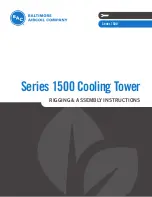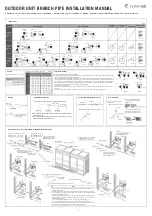
4
P5415467
Take the following precautions to reduce the risk of property damage.
●
Be careful that moisture, dust, or variant refrigerant compounds not enter the refrigerant cycle during
installation work. Foreign matter could damage internal components or cause blockages.
●
If air filters are required on this unit, do not operate the unit without the air filter set in place. If the air
filter is not installed, dust may accumulate and breakdown may result.
●
Do not install this unit in any place where silicon gases can coalesce. If the silicon gas molecules
attach themselves to the surface of the heat exchanger, the finned surfaces will repel water. As a
result, any amount of condensate can overflow from the condensate pan and could run inside of the
electrical box, possibly causing electrical failures.
●
When installing the unit in a hospital or other facility where electromagnetic waves are generated
from nearby medical and/or electronic devices, be prepared for noise and electronic interference
Electromagnetic Interference (EMI). Do not install where the waves can directly radiate into the
electrical box, controller cable, or controller. Inverters, appliances, high-frequency medical equipment,
and radio communications equipment may cause the unit to malfunction. The operation of the unit
may also adversely affect these same devices. Install the unit at least 10 ft. (approximately 3m) away
from such devices.
●
When a wireless zone controller is used, locate at a distance of at least 3.3 ft. (approximately 1 meter)
between the indoor unit and electric lighting. If not, the receiver part of the unit may have difficulty
receiving operation commands.
●
Do not install the unit in any location where animals and plants can come into direct contact with the
outlet air stream. Exposure could adversely affect the animals and plants.
●
Do not install the unit with any downward slope to the side of the drain boss. If you do, you may have
water flowing back which may cause leaks.
●
Be sure the condensate hose discharges water properly. If connected incorrectly, it may cause leaks.
●
Do not install the unit in any place where oil can seep onto the units, such as table or seating areas in
restaurants, and so forth. For these locations or social venues, use specialized units with oil-resistant
features built into them. In addition, use a specialized ceiling fan designed for restaurant use. These
specialized oil-resistant units can be ordered for such applications. However, in places where large
quantities of oil can splash onto the unit, such as a factory, even the specialized units cannot be used.
These products should not be installed in such locations.
Installation Precautions
To reduce the risk of serious injury or death, the following installation
precautions must be followed.
●
When installing the unit into…
▫ A wall: Make sure the wall is strong enough to hold the unit’s weight. It may be necessary to
construct a strong wood or metal frame to provide added support.
▫
A room: Properly insulate any refrigerant tubing run inside a room to prevent “sweating” that can
cause dripping and water damage to wall and floors.
▫
Damp or uneven areas: Use a raised concrete pad or concrete blocks to provide a solid, level
foundation for the unit to prevent water damage and abnormal vibration.
▫
An area with high winds: Securely anchor the outdoor unit down with bolts and a metal frame.
Provide a suitable air baffle.
▫
A snowy area (only for heat pump model): Install the outdoor unit on a raised platform that is
higher than drifting snow. Provide snow vents.
●
Do not install the unit in the following places. Doing so can result in an explosion, fire, deformation,
corrosion, or product failure.
▫ Explosive or flammable atmosphere
▫ Where fire, oil, steam, or powder can directly enter the unit, such as in close proximity or directly
above a kitchen stove.
▫
Where oil (including machinery oil) may be present.
▫ Where corrosive gases such as chlorine, bromine, or sulfide can accumulate, such as near a hot
tub or hot spring.
▫ Where dense, salt-laden airflow is heavy, such as in coastal regions.
▫
Where the air quality is of high acidity.
▫
Where harmful gases can be generated from decomposition.
ii
Summary of Contents for DCP09CSB11S
Page 40: ...32 ...






































